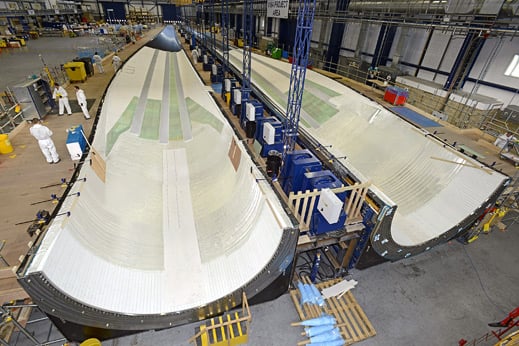The Quest for the Monster Wind Turbine Blade
Blade Dynamics, a six-year-old company that’s partly owned by American Superconductor, a wind turbine designer and supplier of wind farm electronics, says that it has developed technology that will make possible the world’s largest wind turbine blades. It’s demonstrated the technology by manufacturing 49-meter blades, and now the Energy Technologies Institute, a partnership between the U.K. government and major corporations such as BP, Shell, and Caterpillar, has given the company nearly $25 million to build 100-meter blades. They could enable 250-meter-tall wind turbines that would tower over the Washington Monument, which stands a mere 169 meters tall. The largest wind turbine blades now are 75 meters long (see “A Mighty Wind Turbine”).

The effort is no mere record-setting spectacle. Finding affordable ways to make the enormous wind turbine blades is one of the biggest challenges to making offshore wind competitive with fossil fuels, and leading wind power companies, including GE and Vestas, are developing technology to solve the problem.
Some of the best winds for generating power are found offshore, where wind can be steadier, faster, and less turbulent than on land. Wind turbines only make up about a third of the cost of offshore wind farms—installation costs are the major expense, as they involve enormous, specialized ships and are subject to delays from bad weather. Using larger wind turbines reduces the number of wind turbines needed, decreasing installation and maintenance costs (see “Building Bigger, Better Wind Turbines” and “The Great German Energy Experiment”).
One problem with building very large wind turbines is that the cost of making the blades is skyrocketing. As wind turbines get bigger, the loads on the blades, and therefore their weight, goes up exponentially. The conventional way for making blades involves forms that are as long as the blades themselves. The forms and other equipment needed to make them are becoming so big and specialized that there are few suppliers, which increases prices for manufacturing equipment. Making sure the blades are formed accurately also gets more and more difficult as blades get longer.
Some major wind turbine manufacturers are sticking with the large forms, but are adopting carbon-reinforced fiberglass blades and new blade designs to offset some of the manufacturing cost increase. They’re also counting on savings in installation and other costs to make the business case for larger wind turbines. Siemens, for example, is using large forms for its 75-meter blades, as is Vestas, which is developing 80-meter blades for a wind turbine that will be available next year.
While manufacturers like Vestas are using carbon-reinforced blades, Blade Dynamics is making blades entirely out of carbon fiber. The company has developed proprietary ways to make 12- to 20-meter sections of carbon fiber blade and then splice them together seamlessly—eliminating the need for large forms. Some previous attempts at modular blades involved bolting blade sections together, but this created stress points within the blades that make them too weak.
Carbon fiber is more expensive than fiberglass, so for a given length, the blades will be more expensive. But David Cripps, senior technical manager at Blade Dynamics, says the use of carbon fiber can improve the overall economics of wind turbines in several ways. By making the blade in smaller sections, it’s possible to make more precise aerodynamic structures, improving performance, he says. Also, because the blades weigh much less than fiberglass ones, it’s possible to put longer blades on existing wind turbine designs. For example, the company’s 49-meter blade weighs no more than a conventional 45-meter blade specified by a wind turbine’s original design. Longer blades gather more wind, allowing the turbines to generate more power at lower wind speeds, increasing revenue.
The lighter blades also make it possible to design new wind turbines that have lighter and less expensive components, such as the drive shaft, tower, and foundation. “Instead of a 24-ton rotor, you might have a 15-ton rotor. That’s substantial weight to save on the end of a long cantilevered tower,” Cripps says.
The development effort is part of American Superconductor’s strategy of bringing 10-megawatt wind turbines to market (offshore wind farms typically use 3.6-megawatt turbines or, more rarely, six-megawatt ones). It’s reducing the weight of the wind turbine generator with the help of superconductor materials, and is developing a 10-megawatt turbines that it says will weigh about as much as five-megawatt ones, to keep installation costs down.
Keep Reading
Most Popular
Large language models can do jaw-dropping things. But nobody knows exactly why.
And that's a problem. Figuring it out is one of the biggest scientific puzzles of our time and a crucial step towards controlling more powerful future models.
The problem with plug-in hybrids? Their drivers.
Plug-in hybrids are often sold as a transition to EVs, but new data from Europe shows we’re still underestimating the emissions they produce.
Google DeepMind’s new generative model makes Super Mario–like games from scratch
Genie learns how to control games by watching hours and hours of video. It could help train next-gen robots too.
How scientists traced a mysterious covid case back to six toilets
When wastewater surveillance turns into a hunt for a single infected individual, the ethics get tricky.
Stay connected
Get the latest updates from
MIT Technology Review
Discover special offers, top stories, upcoming events, and more.